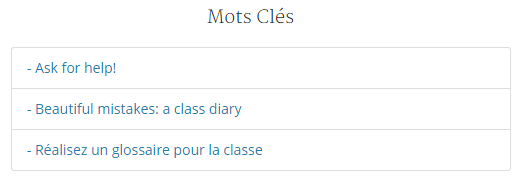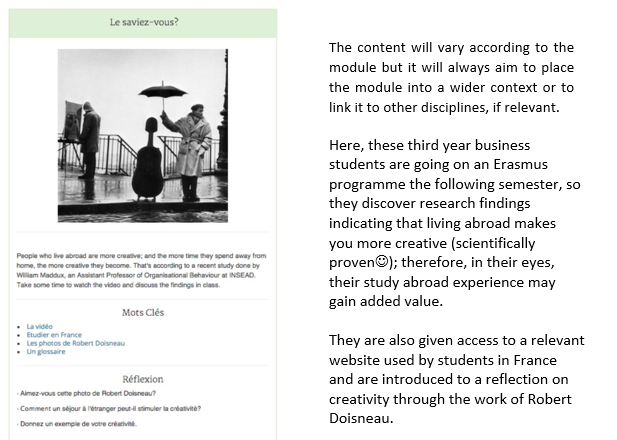Not just a pretty Moodle [inter] face: a brief explanation
Introduction
We (CTEL) have been in working in collaboration with some of our academic colleagues to showcase some of the new user interface styles in Moodle that explores the usability and user experience in Moodle in order to give students both a more visual and engaging experience.
Dr Áine Furlong has kindly agreed to share the pedagogical views that underpin the development of an exciting new style in one of her Moodle modules. In this guest post, Áine shares her ideas…
Why develop an interface for Moodle?
My academic background is Second Language Acquisition (SLA). Over the years, I have come to realise that this experience has informed not just my students’ language learning processes and the teaching decisions I have made, but also learning in general; I believe this extends to the world of learning online – note the word order in the last sentence: ‘learning’ comes first, before ‘online’.
In second language learning and teaching, one of the main concerns is to transform the language learner into a language user (Common European Framework of Reference for Languages, 2001); in contrast and in the digital space, the main focus is on the user and user experience. Here, the terminology connotes consumerism, i.e. consumable and disposable commodities while situations of addiction may also be evoked; such connotations do not suggest positive and transformative learning experiences. Consequently, my principal interest, here, is to reflect on how the online user may be transformed into a learner. The process is intuitive and phenomenological and has led me to choose a two-card approach for the display of and engagement in my Moodle pages.
Why two cards? Because…
Figure 1. Two cards
1. The cards are symmetric tools; the idea of symmetry is important because, as Oviatt (2013) points out, bilateral and 3D congruent symmetry, in evolutionary terms, contributed to ‘greater structural integrity and durability’ while extending the possibilities with more power and precision in the actions taken by our ancestors (p.15). Here is an illustration of such tools:
Figure 2. Hand axe with 3D congruent symmetry
And below … the same tool with added components providing multimodality enabled by symmetry (Figure 3.):
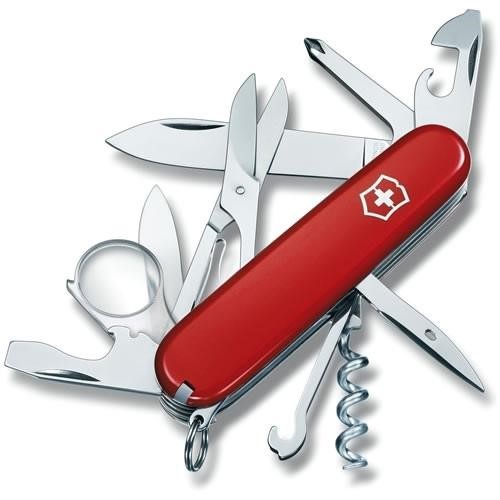
Figure 3. A Swiss penknife
Symmetry also makes visual perception easier. Initially, the two Moodle cards were intuitively conceived with symmetry, balance, integrity, congruence, efficiency and durability in mind. However, additional reasons for this design are provided below.
2. There are two ways of acquiring knowledge:
Acquisition – what we learn informally, outside the classroom;
and
Learning – what we learn formally, through instruction.
This distinction is well established in second language acquisition theories (Krashen, 1981). However, it is relevant to the acquisition of knowledge in general given our students’ growing reliance on external sources to support their learning and this, in the context of a knowledge-based society. The challenge for us, educators, is to find ways of reconciling the formal and the informal, acquisition and learning, in meaningful ways. The two cards represent an attempt at this reconciliation and require a lot more work!
3. The two cards will always have an in-between space. This space is potentially creative (see Homi K. Bhabha, 1994) because it creates the opportunity for dialogue and movement between the two cards. Dialogue can emerge from a variety of scenarios such as analysis (space) and memory (time) – space and time are the two pre-existing dimensions out of which human cognition emerges -, compare-and-contrast, then-and-now, before-and-after, face-to-face instruction and online activity, theory and applications, lectures and lab work. The movement is from left to right and right to left, with minimal vertical eye movement.
To summarise so far, the foundations of the two cards rest on symmetry and encourage a dialogical approach to learning. The cards contain a variety of features such as images, text, a maximum of 3 (or 4) links and reflective questions, the purpose of which will be explained as we progress through the rationale.
Each card becomes a teaching instrument/tool in itself and can be used in class or can be further developed for learning online or in class.
Why images? Because…
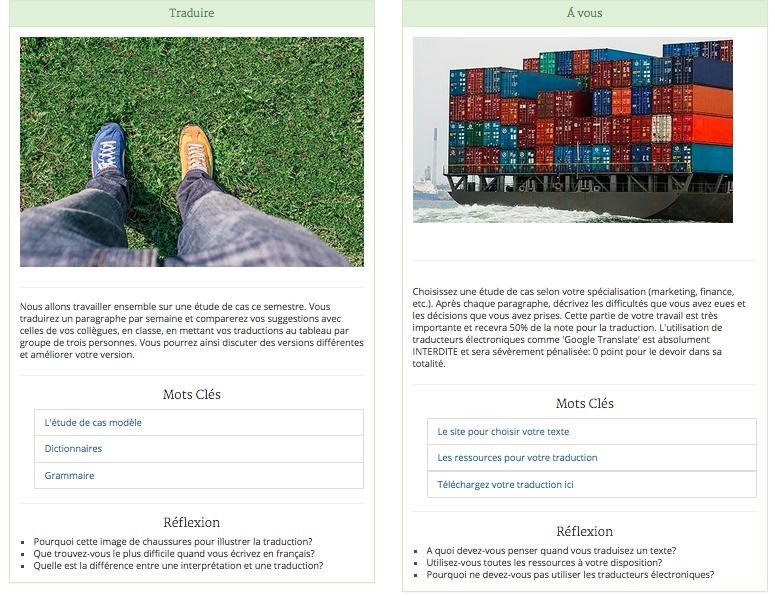
Figure 4. Images for the two cards
Photos account for 93% of the most engaging posts on Facebook. Photos get 53% more likes, 104% more comments and 84% more click-throughs on Facebook. On Twitter, 150% more retweets (Corkery, 2015). In the Moodle context, images may trigger questions, comments or may be used as icebreakers and markers.
I prefer images that make people think, smile, wonder, images that extend the viewer’s mind. These images are not illustrations; instead, they become the trigger for more talk… in French of course.
I will gladly respond to any queries regarding these images in French and/or in English (![]() ).
).
Why key words? Because…
Figure 5. Keywords for the two cards
Here, key words (mots clés) appear in their literal sense: they should be seen as keys that open doors (not necessarily important words related to the topic in question); this is why they are linked to a variety of activities, websites, documents, tools, etc. enabling a multimodal approach where a sensorial approach to learning is promoted; for example, a web tool such as Blendspace provides access to multiple websites, tools and promotes multiple modes of learning. Similarly Vygotsky’s principle of mediation comprises psychological tools or the embodiment of learning – gestures, language, sign systems, mnemonic techniques and decision-making systems - as well as interpersonal communication, i.e. socially meaningful activity. Here is an example of how mediated content via one keyword/link to Blendspace reveals itself as a multimodal learning experience based on a news item in France:
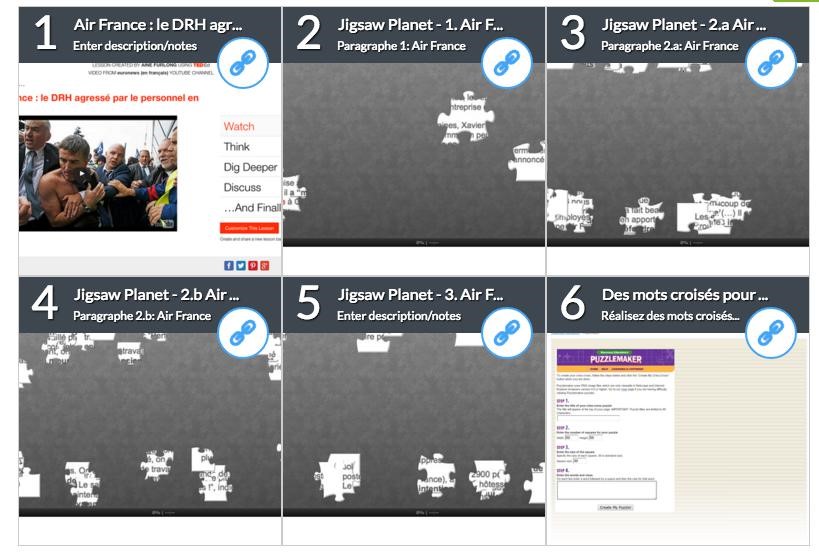
Figure 6. Multimodal learning stimuli
Figure 6. displays six tiles. The first tile (1) is a link to Ted Ed, a didacticised version of the TV report (visual and audio stimuli); Tiles 2-4 contain the original text of the news item in the form of jigsaw puzzles which can be completed online (spatial awareness, hand-eye coordination and memory of the text seen in the previous activity); Tile 6 gives students access to Puzzlemaker where their own crossword puzzles can be created by re-using and defining newly learned words to ultimately challenge their peers (analysis, memory, visual stimulus, interpersonal communication).
The three key words or links may also be used for additional purposes, as displayed in Figure 5. . First, the diary: beautiful mistakes… This again comes from second language acquisition studies reporting that where most learning is done is where most mistakes are made (Dalton-Puffer, 2009). A class diary where mistakes are recorded and explained, as well as corrected, provides students and lecturers with valuable insights into learning processes. For the student, this means awareness and better understanding; for the lecturer this represents useful data for better teaching and/or research.
An additional thought, this time from philosophy (Halpin, Clark and Wheeler, 2014) evokes the ‘extended mind hypothesis’, which posits that ‘cognitive processes are not always confined within the boundaries of skin and skull’ (p.24). Writing is a good illustration of this hypothesis as pen and paper become ‘constitutive of thinking’. The process is described as ‘technology-mediated cognitive empowerment’ (Smart, 2014, pp.123 -4). So, this is what happens with pen and paper; imagine what could happen with technology as we commit more and more to computers and mobile technology. The ‘beautiful mistakes’ diary is an application of the ‘extended mind hypothesis’ as cognitive choices made by students become transparent, insightful and transformative, thanks to writing and technology. Additional applications of this hypothesis could be in the form of a weekly class diary or a newsletter reporting on what has been learned, in the students’ own words.
The ‘extended mind hypothesis’ is evolving into another concept, that of ‘collective intelligence’, because the acquisition and learning of knowledge is collectively scaffolded. The ‘ask for help’ forum and the class glossary are two additional examples of collective intelligence at work (Figure 5).
P.S.: the same glossary appears several times in various sections of the Moodle page to add new knowledge to older knowledge, on an on-going basis.
Why three questions? Because…

Once more, this has to do with the ‘extended mind hypothesis’. The questions not only serve as conversation topics but can also be used for revision in or outside class, before an exam. They are deliberately broad to enable students to integrate prior knowledge as well as what they have formally and informally learned. They can also act as connectors between other modules taken by the students. In other words, they are designed to overcome the fragmentation of our educational environment.
The fragmentation issue is also addressed in the card below. This card will appear in all my modules and is entitled ‘Le saviez-vous?’/ (Did you know…)
Figure 7.
Why three cards now? Because…

Figure 8. Three cards for categories: ‘Outils de travail’ (Tools of the trade)
The resources in languages are infinite and make for very poor display on my old Moodle page. A long list of stuff, of no-things!
The three-card display does not appear in any of the sections. Instead, students can access the display by clicking on the relevant link in the relevant cards. Users are never more than one click away and are not overwhelmed by the long list. The three-card display helps to categorise the resources clearly and to be more selective. Note that the website URL for each resource is not masked. This is intentional as it targets the viewer’s perception and shows these resources as actual (technological) tools.
Three cards are also useful for separate foci on one theme within one section of the module as illustrated in Figure 9. below. The example is taken from another module. However, note that the three foci are considered together in a forum-like tool (Padlet – Figure 10.) to build on both the ‘extended mind hypothesis’ and the ‘collective intelligence’.

Figure 9. One theme, three separate foci and a forum below the three cards (one link).

Figure 10. An example of the Padlet forum to promote the extended mind hypothesis and the collective intelligence (one theme, three separate foci)
Padlet in Figure 10. enables students to post thoughts, images, films and audio material to exchange and construct knowledge on a particular theme.
To conclude, this work is only the beginning… much remains to be done to better understand the phenomenon of learning online. I believe that multimodality in learning is also applicable to the research of 21st century pedagogies to include disciplines such as philosophy, graphic design, anthropology, education, second language acquisition, psychology, literacy studies, computer sciences and more.
Finally, thank you for considering a few, if not all of these points, should you decide to use this template for learning and teaching online; thank you also for adding more insights to the template, if you wish to do so. Just let us know, so that the collective intelligence of Waterford Institute of Technology continues to grow.
The author wishes to thank Eamonn de Leastar, Laura Widger, Conor O’Neill and Cathal O’Riordán for their extended and collective insights.
References:
Bhabha Homi K. (1994) The location of culture. London: Routledge.
Corkery, C. (2015) 13 Easy-to-Use Tools for Creating Killer Visual Content. Available at: http://www.verticalresponse.com/blog/13-easy-to-use-tools-for-creating-killer-visual-content (Accessed: 12 May 2015).
Common European Framework of Reference for Languages (2001). Cambridge, UK: CUP.
Dalton-Puffer, C. 2009. ‘Communicative competence and the CLIL lesson’, in Ruiz de Zarobe, Y. and Jimenez Catalan, R. (Eds.) Content and Language Integrated Learning: Evidence from Research in Europe . Clevedon: Multilingual Matters, pp. 197-214.
Halpin, H., Clark, A. and Wheeler, M. (2014) ‘Philosophy of the Web: Representation, enaction, collective intelligence’ in Halpin, H. and Monnin, A. (eds) Philosophical engineering, Toward a philosophy of the Web. Chichester: Wiley-Blackwell, pp.21-30.
Krashen, S. D. (1981) Second language acquisition and second language learning. Oxford: Pergamon Press.
Oviatt, S. (2013) The Design of future educational interfaces. New-York: Routledge.
Smart, P.R. (2014 ) ‘The web-extended mind’, in Halpin, H. and Monnin, A. (eds) Philosophical engineering, Toward a philosophy of the Web. Chichester: Wiley-Blackwell, pp.116-33.
Vygotsky, L. (2002) Thought and language (A.Kozulin, ed.). Cambridge, MA.: MIT Press.


